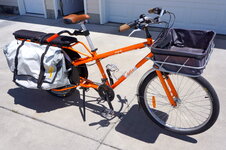I have a cargo bike, a Yuba Mundo Classic, it's 7 feet long and I'm thinking of going with a rear hub 72V 2000 watt motor and 72V battery. I keep reading how some members are saying that 52V is safer than 72V.
What do they mean by that? How could 72V be less safe than 52V? I plan on using the bike as a car replacement, so I'll be using it to get groceries and take my 6 year old to school. I'm just wondering if I should go with a 52V instead of the 72V battery and motor combo for safety reasons, I won't want my kid to get shocked but I'm new to ebike building so I don't understand how the battery can malfunction.
Here there hulk, hopefully I can help you a bit.
I have a Surly Big Dummy Cargo bike that I have converted to electric. I went with 2WD, 52V using 9C 1500 watt motors.
I also did some silly...installing 6 x 23.8Ah 52V batteries (hence the cargo bike choice in the first place for this build, to carry all that battery weight). I have around 130lbs of custom frame and batteries on the back, carry a 20-30lb bag on top and I'm currently 270lbs of rider.
Note I did look at the Mundo as well when I was shopping for the bike and it's a great choice. I just found the Surly was a better fit for me and my LBS is amazing and they carried Surly.
Things to consider:
-Way more selection out there for 52V setups. Motors, batteries, etc.
-Components like PAS and Torque PAS often are limited to 52V or less - not compatible with 72V.
-72V Batteries are much harder to find and a price premium per Wh compared to 52V options. This is important when you may consider perhaps having 2, 3 or 4 batteries for all day riding (carry the extras on your cargo bike or install multiple on the frame).
-52V Motors can easily maintain 28mph/45kmph. On a cargo bike with lots of weight out back, you really do not want to ever go faster than 30mph. The reason riders go 72V is to push motors up to 40mph+ usually.
Now, some real world riding insight.
I built my cargo bike up with 2WD from day one....because I could. LOL. Watching my CA3 computer screen I can tell you that with 400lbs of payload (me the rider plus everything out back) I am only using 400-1000watts 90% of the time and I'm cruising along at 25mph/40kmph all the time.
When do I use the 2WD? Hills of course. With both motors on tap I can climb even 10% grade hills at 25mph/40kmph which blew my mind when I first experienced it.
Yeah 2WD is overkill...but I was bored at home in covid lockdowns and decided to build this beast.
I do appreciate having the second motor so if I have a motor failure I still have the second in place to get me home. I also like hub motors for the safety of breaking a chain the hub motor still works.
With my 6 batteries I have a 300-350km range with my riding/fitness level. I also have a Burly trailer to test out this year making my 7ft bike (like yours) plus 6ft of trailer into a 13ft 'train' going down the highway.
If I was helping you with your build and you decided to stick with RWD and not consider 2WD (budget, complexity, etc - totally understand) I would suggest:
-1500watt Rear Hub Motor with cooling solution within - example -
https://ebikes.ca/shop/electric-bicycle-parts/motors/rh212-std.html - $20 extra for 'statorade' is well worth it
-Controller, computer, PAS or torque sensor in the bottom bracket of your choice.
-2 (or more) 17AH down tube batteries or a large single triangle battery if it has enough Ah/Wh for your day to day needs.
I'm helping a buddy build a cargo bike of his own (used Big Dummy) with a single RWD motor and 3 x 17AH batteries to replace his car just like you are considering. He lives in Toronto during the warmer months and Florida in the winter so even if he has to go 'slower' up hills occasionally he will be fine with the 52V 1500Watt motor and with the 3 batteries he will have 120kms/75miles of distance per day estimated, little less with a lot of cargo loaded on.
Any questions let me know and I will help. I log in every few days so if I'm slow to reply I apologize in advance.


